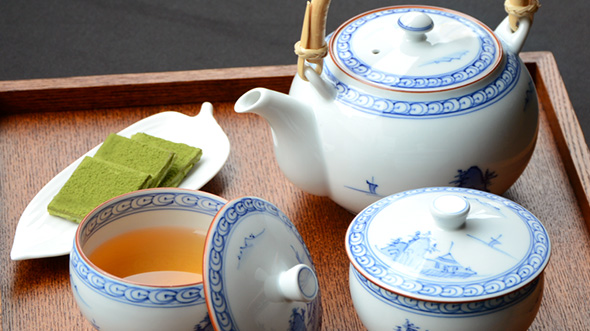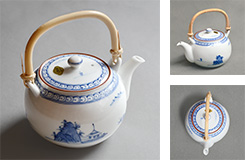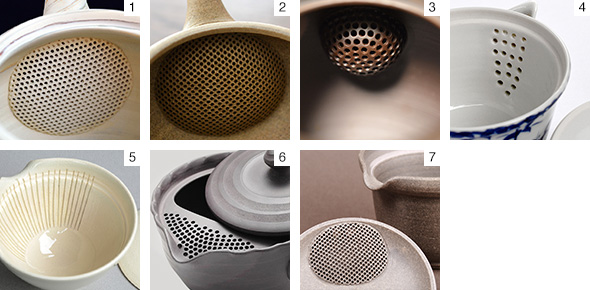
With so many shapes and styles of teapots and teacups available today, it can be difficult to choose the best Japanese tea set simply based on personal preferences alone. Additionally, through centuries of green tea consumption in Japan, the shapes and sizes of teapots and teacups have evolved over time to help bring out characteristics of specific green tea varieties. If you would like to finally understand these often confusing difference in design, we invite you to keep reading.
Information that is covered:
Choosing a Japanese Teapot
Beyond stylistic preferences, we suggest considering the following four criteria when shopping for a Japanese teapot: material, shape, size, and filter type.
Clay vs. Porcelain Teapots
In general, Japanese teapots are made with either clay (stoneware) or porcelain materials. Porcelain teapots are versatile in their ability to brew just about any tea since the pot doesn’t absorb the aroma of the tea.
As for clay teapots, you will find more interplay between the tea and the pot. Clay varieties like Tokoname-yaki and Banko-yaki are known for contributing to a mellower tasting tea as well as enhancing the umami component. This is because the clay contains a high iron content, which causes a chemical reaction with the tannins found in the tea leaves.
4 Basic Japanese Teapot Shapes
There are four basic shapes for Japanese teapots with the main difference found in the handle’s design. If you have researched Japanese teapots before, you may also be confused between the difference between a Japanese teapot and a “kyusu”; the two are one and the same.




Japanese Teapot Sizes
It is important to consider which teapot size is best for your chosen tea when shopping for a teapot.
For example, if you like gyokuro, and often enjoy it by yourself, it is wise to acquire a hohin. If you and your family likes hojicha after dinner, then you might want to choose a large dobin.
It is possible to prepare sencha by using a large teapot with a dobin handle. However, please note that the water temperature can be difficult to control, resulting in inconsistent steeping.
Clay vs. Metal Teapot Filters
Almost always the preferred choice in high-quality Japanese teapots, clay filters are built into the teapot, using the same materials as the vessel. Unlike many stainless steel teapot filters, the clay filters allow the tea to fully steep in the water without coming into contact with any metal. The only downside of a built-in filter design is that it takes greater care as the filter holes can sometimes become obstructed; but this is easily countered by the clay filter’s ability to produce a higher quality brewing.

| Filter Name | Filter Design | Representative Japanese Ware | |
|---|---|---|---|
| 1 | Sasame | Wide surface, smallest hole size | Tokoname |
| 2 | Ceramesh | Wide surface | Tokoname |
| 3 | Tomochakoshi | Half-ball shape | Banko and Tokoname |
| 4 | Donuki | Holes directly in the vessel wall | Bizen and Kiyomizu |
| 5 | Shiboridashi | Hohin without holes | Shigaraki and Tokoname |
| 6 | Tsukumo | Above the pour spout but under the lid | Tokoname |
| 7 | Tenro | Inner side of the lid | Tokoname |
Do I Need a Yuzamashi?
Yuzamashi is a lidless cooling cup with a back or side handle and sometimes a pour spout. It is used to cool down the boiled water to a desired temperature or serve tea. Yuzamashi is not an essential accessory for most tea varieties, however, it is a wonderful addition for green tea enthusiasts.

Choosing a Japanese Teacup
Once you have found your favorite green tea and the right teapot, all you need is the perfect Japanese teacup to bring out the tea’s flavor and aroma.
Unlike Japanese teapots, there are not hard rules or guidelines assigning a specific teacup shape to a specific tea variety. However, since each tea variety is steeped differently to enhance its unique qualities, it is worth taking the time to learn about the different types of Japanese teacups available.
Japanese Teacup Materials
In general, teacups come in three types: porcelain, clay and glass.
Porcelain Teacups
Japanese porcelain teacups are very popular in Japan and can be found in most Japanese homes. They are thin, lightweight and come in a variety of shapes and sizes.
Clay Teacups
Also very popular in Japan, clay teacups offer a more traditional Japanese aesthetic with their fire-glazed appearance. The Japanese phrase “wabi-sabi” would be a perfect word to describe this style.
Glass Teacups
Glass teacups are a good choice primarily for ice-cold green tea on a hot summer day.
Japanese Teacup Shapes
There seems to be almost too many subtle Japanese teacup shapes to count, however, most shapes generally fall in one of the following three categories.

Teacups with Tapered Sides
Tea cups of this shape can enhance the green tea’s aroma and are a great option for varieties like gyokuro and sencha.

Teacups with Straight Sides
The stately silhouette of this shape functions to maintain the temperature of tea. Therefore, it can be a good option when drinking hojicha or genmaicha as both require a higher steeping temperature.

Teacups with Lids
While a teacup with a lid may hold the heat in longer, its primary function is that of decoration when serving green tea to guests.
Considering the Teacup’s Color
The teacup’s color is ultimately based on your preferences, however, there is the following consideration. For green tea, the color of the teacup matters more on the inside than the outside since it can affect the visual color of the tea when poured into the cup. As such, you may wish to acquire an additional set of white teacups for when showing the vibrant color of the green tea is important.
Choosing the Best Japanese Tea Set for Your Favorite Green Tea
The information above should guide you in choosing both a teapot and teacup that enhances your green tea experience. However, if some of the concepts explained here are still a little difficult to put together, you can use the following table to help you choose the best Japanese tea set by green tea variety.
| Tea Variety | Teapot Size | Teacup Size | Recommended Tea Set | |
|---|---|---|---|---|
| Gyokuro | 120 cc | 40 cc | Bamboo Hohin + Bamboo Yuzamashi + Bamboo Gyokuro Tea Cup |  |
| Kabusecha | 130 cc | 70 cc | Hasamiyaki Hira Kyusu + Hasamiyaki Tea Cup |  |
| Sencha | 250 cc | 120 cc | Sabisenmon Kyusu + Sabisenmon Tea Cup |  |
| Fukamushicha | 240 cc | 90 cc | Hokuryu Fukurogata Kyusu + Pine Needle Tea Cup |  |
| Kukicha (Karigane) | 220 cc | 60 cc | Takasuke Ivory Kyusu Large + Mino Sorigata Yunomi |  |
| Konacha | - | 160 cc | Chakoshi + Hakeme Tsutsu Yunomi |  |
| Kamairicha | 250 cc | 140 cc | Gyokko Yakishime Tea Set |  |
| Genmaicha | 270 cc | 120 cc | Gyokko Yohen Tea Set |  |
| Hojicha | 600 cc | 130 cc | Kyoesansui Tea Set |  |





